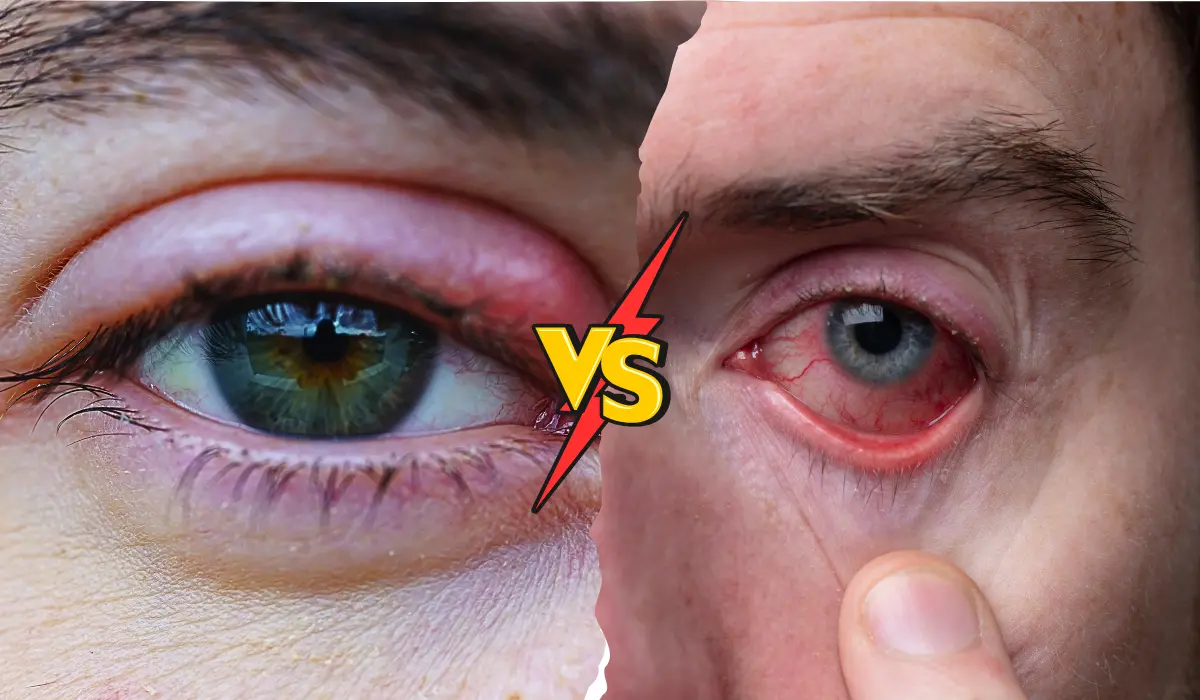Ah, the pesky eye issues! Whether it’s a stye or pink eye, dealing with these conditions can be a real pain (quite literally). Let’s break it down and demystify these two common eye afflictions.
A stye, also known as a hordeolum, is a painful, red bump that forms on the eyelid due to an infected eyelash follicle or oil gland. It’s like a tiny, angry pimple that decides to pitch its tent on your eye.
On the other hand, pink eye, or conjunctivitis, is an inflammation of the thin, clear membrane (conjunctiva) that lines the inside of the eyelid and covers the white part of the eyeball. It’s like a fiery sunset spreading across your peepers, but not quite as romantic.
These two conditions are often confused due to their similar symptoms, which can lead to some serious eye-rolling (pun intended) if misdiagnosed.
Key Takeaways
- Different Causes: Styes are localized infections, while pink eye affects the entire eye surface.
- Treatment Approach: Use warm compresses for styes and antibiotics for bacterial pink eye.
- Prevention: Wash hands often, avoid sharing items, and remove eye makeup before bed.
Causes And Symptoms
A stye is typically caused by a bacterial infection, often due to Staphylococcus aureus(NIH). It can also be triggered by blocked oil glands or a foreign object irritating the eye. Meanwhile, pink eye can be viral or bacterial in nature, with viruses being the most common culprit.
With a stye, you’ll likely experience a painful, red bump on the eyelid, accompanied by swelling and tenderness. It’s like having a tiny, throbbing houseguest that refuses to leave.
Pink eye, on the other hand, presents itself with redness, itchiness, and a bothersome discharge that can make your eyes feel like they’re participating in a never-ending cry-fest. The discharge can be watery, mucus-like, or even resemble pus (yummy!).
The key difference lies in the location of the infection. A stye is localized on the eyelid, while pink eye affects the entire eye surface and inner eyelid.

Treatment Options For Stye And Pink Eye
There are solutions to these eye-catching predicaments.
For styes, warm compresses can work wonders by encouraging drainage and relieving pain. If the stye persists or worsens, your trusty eye doctor may prescribe antibiotic ointments or even suggest surgical drainage (yikes!).
As for the pink eye, antibiotic eye drops can vanquish bacterial villains, while antihistamines can soothe viral invaders. However, if your symptoms persist or worsen, it’s time to seek medical attention from an eye care professional.
Remember, proper hygiene is crucial in preventing the spread of these infections. Avoid sharing towels, pillows, or makeup, and resist the urge to touch or rub your eyes (no matter how tempting it may be).

How To Prevent Stye And Pink Eye?
Prevention, as they say, is better than cure (and a whole lot less painful, too). Here are some tips to keep those pesky eye issues at bay:
For Styes:
- Avoid touching your eyes with dirty hands (seriously, keep those mitts clean!)
- Remove eye makeup before hitting the hay (no raccoon eyes allowed!)
- Maintain good eyelid hygiene by gently cleaning the area with a warm, clean cloth
For pink eye:
- Wash your hands frequently (like, all the time!)
- Avoid sharing towels, pillows, or anything else that touches your eyes
- If you wear contacts, be diligent about cleaning and replacing them as directed
Additionally, certain underlying health conditions, such as blepharitis (chronic eyelid inflammation) or diabetes, can increase your risk of developing styes or pink eye. So, stay on top of your overall health, and don’t hesitate to consult a medical professional if you have concerns.
Must Read: Stye Vs Blepharitis: Unraveling The Mystery Of Eyelid Troubles
Expert Advice On Stye Vs Pink Eye
To shed some expert light on these eye afflictions, we consulted Dr. Emily Johnson, a renowned ophthalmologist with over 15 years of experience in treating eye disorders.
“Styes and pink eye may seem similar at first glance, but they need different approaches,” Dr. Johnson explains. “With a stye, it’s crucial to avoid squeezing or popping it, as this can lead to further infection and even vision complications. Instead, apply warm compresses and seek medical attention if the stye doesn’t improve within a week or if you experience vision changes.”
For pink eye, Dr. Johnson emphasizes the importance of proper diagnosis. “While viral and bacterial pink eye share some symptoms, their treatment differs. Viral cases typically resolve on their own within a week or two, but bacterial infections require antibiotic eye drops prescribed by an eye doctor. Seeking medical attention is crucial to avoid complications and ensure proper treatment.”
Also Read: What Are The Worst Eye Diseases? Exploring The Most Serious Eye Conditions
Conclusion
In the battle of Styes versus pink eye, it’s crucial to distinguish between these two eye-catching adversaries. While they may share some similarities, their causes, locations, and treatment approaches differ.
If you suspect you have either condition, don’t hesitate to seek medical advice. Your eye doctor is your best ally in conquering these pesky invaders and restoring your eyes to their radiant, healthy state.
Remember, good eye hygiene is your ultimate defense against these unwanted guests. Keep those hands clean, avoid sharing personal items, and be mindful of your overall health. With a little extra care and attention, you can bid farewell to styes and pink eye, and embrace a world of clear, comfortable vision.





